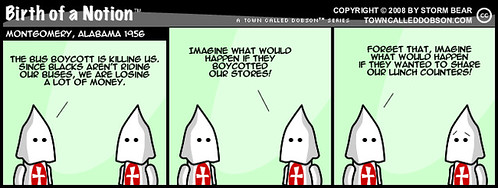 click to enlarge From Wikipedia: The Montgomery Bus Boycott was a political and social protest campaign started in 1955 in Montgomery, Alabama, intended to oppose the city's policy of racial segregation on its public transit system. The ensuing struggle lasted from December 1, 1955, to December 20, 1956, and led to a United States Supreme Court decision that declared the Alabama and Montgomery laws requiring segregated buses unconstitutional. Under the system of segregation used on Montgomery buses, white people who boarded the bus took seats in the front rows, filling the bus toward the back. Black people who boarded the bus took seats in the back rows, filling the bus toward the front. Eventually, the two sections would meet, and the bus would be full. If another black person boarded the bus, he was required to stand. If another white person boarded the bus, then everyone in the black row nearest the front had to get up and stand, so that a new row for white people could be created. Rosa Parks was sitting in the front-most row for black people. When a white man boarded the bus, everyone in her row was expected to move back to create a new row for the whites. While all of the others in her row complied, Rosa refused, and was arrested for failing to obey the driver's seat assignments, as city ordinance did not explicitly mandate segregation, but gave the bus driver authority to assign seats. Rosa Parks was born on February 4, 1913 in Tuskegee, Alabama. She was a seamstress by profession and secretary for the Montgomery chapter of the NAACP. Shortly before being arrested on December 1, 1955, she had completed a course in "Race Relations" at the Highlander Folk School in Tennessee where nonviolent civil-disobedience had been discussed as a tactic. The boycott was triggered by her arrest--when she was charged for violating racial segregation laws in Montgomery after refusing to give up her bus seat to a white man. She was sitting in the fifth row (the first row that blacks could occupy), along with three other blacks. Soon, all of the first four rows were filled up, and a white man walked on. Since blacks and whites could not be in the same row, the bus driver insisted for all of the blacks to move. The other three blacks complied, but Parks refused and was dragged off of the bus. Her arrest immediately followed. When found guilty on December 15, Parks was fined $10 plus a court cost of $4, but she appealed. As a result, Rosa Parks is considered one of the pioneers of the civil rights movement. Some kind of action against segregation had been in the works for some time before Rosa Parks' arrest, under the leadership of E. D. Nixon, president of the local NAACP chapter and a member of the Brotherhood of Sleeping Car Porters. Nixon intended that her arrest be a test case to allow Montgomery's black citizens to challenge segregation on the city's public buses. With this goal, community leaders had been waiting for the right person to be arrested, a person who would anger the black community into action, who would agree to test the segregation laws in court, and who, most importantly, was "above reproach." When fifteen year old Claudette Colvin was arrested early in 1955 for refusing to give up her seat to a white man, E.D. Nixon thought he had found the perfect person, but the teenager turned out to be pregnant. Nixon later explained, "I had to be sure that I had somebody I could win with." Parks, however, was a good candidate because of her employment and marital status, along with her good standing in the community. Between Parks' arrest and trial, Nixon organized a meeting of local ministers at the church of Rev. Martin Luther King, Jr. Though Nixon could not attend the meeting because of his work schedule, he arranged that no election of a leader for the proposed boycott would take place until his return. When he returned he caucused with Ralph Abernathy and Rev. E.N. French to name the association to lead the boycott (they selected the 'Montgomery Improvement Association' ("MIA")) to the city, and select Rev. King (Nixon's choice) to lead the boycott. Nixon wanted King to lead the boycott because the young minister was new to Montgomery and the city fathers had not had time to intimidate him. At a subsequent, larger meeting of ministers, Nixon's agenda was threatened by the clergy men's reluctance to support the campaign. Nixon was indignant, pointing out that their poor congregations worked to put money into the collection plates so these ministers could live well, and when those congregations needed the clergy to stand up for them, those comfortable ministers refused to do so. Nixon threatened to reveal the ministers' cowardice to the black community, and Rev. King spoke up, denying he was afraid to support the boycott. King agreed to lead the MIA, and Nixon was elected its treasurer. On the night of Rosa Parks's arrest, Jo Ann Robinson, head of the Women's Political Council printed and circulated a flyer throughout Montgomery's black community which read as follows:
The next morning at a church meeting led by the new MIA head, Rev. King, a citywide boycott of public transit was proposed to demand a fixed dividing line for the segregated sections of the buses. Such a line would have meant that if the white section of the bus was oversubscribed, whites would have to stand; blacks would not be forced to remit their seats to whites. This demand was a compromise for the leaders of the boycott who believed that the city of Montgomery would be more likely to accept rather than demand for a full integration of the buses. In this respect, the MIA leadership followed the pattern of earlier boycott campaigns in the Deep South during the 1950s. A prime example was the successful boycott a few years earlier of service stations in Mississippi for refusing to provide restrooms for blacks. The organizer of that campaign, T.R.M. Howard of the Regional Council of Negro Leadership, had spoken in Montgomery as King's guest at the Dexter Avenue Baptist Church only days before Parks's arrest. This demand was to be supplemented by a requirement that all bus passengers receive courteous treatment by bus operators, be seated on a first-come, first-served basis, and blacks be employed as bus drivers. The proposal was passed, and the boycott was to commence the following Monday. To publicize the impending boycott it was advertised at black churches throughout Montgomery the following Sunday. On Saturday, December 3, it was evident that the black community would support the boycott, and very few blacks rode the buses that day. That night a mass meeting was held to determine if the protest would continue, and attendees enthusiastically agreed. The boycott proved extremely effective, with enough riders lost to the city transit system to cause serious economic distress. Martin Luther King later wrote "[a] miracle had taken place." Instead of riding buses, boycotters organized a system of carpools, with car owners volunteering their vehicles or themselves driving people to various destinations. Some white housewives also drove their black domestic servants to work, although it is unclear to what extent this was based on sympathy with the boycott, versus the desire to have their staff present and working. When the city pressured local insurance companies to stop insuring cars used in the carpools, the boycott leaders arranged policies with Lloyd's of London. Black taxi drivers charged ten cents per ride, a fare equal to the cost to ride the bus, in support of the boycott. When word of this reached city officials on December 8, 1955, the order went out to fine any cab driver who charged a rider less than 45 cents. In addition to using private motor vehicles, some people used non-motorized means to get around, such as cycling, walking, or even riding mules or driving horse-drawn buggies. Some people also hitchhiked. During rush hours, sidewalks were often crowded. As the buses received extremely few, if any, passengers, their officials asked the City Commission to allow stopping service to black communities. Across the nation, black churches raised money to support the boycott and collected new and slightly used shoes to replace the tattered footwear of Montgomery's black citizens, many of whom walked everywhere rather than ride the buses and submit to Jim Crow laws. In response, opposing whites swelled the ranks of the White Citizens' Council, the membership of which doubled during the course of the boycott. The councils sometimes resorted to violence: Martin Luther King's and Ralph Abernathy's houses were firebombed, as were four black Baptist churches. Boycotters were often physically attacked. Under a 1921 ordinance, 156 protesters were arrested for "hindering" a bus, including King. He was ordered to pay a $500 fine or serve 386 days in jail. He ended up spending 2 weeks in prison. The move backfired by bringing national attention to the protest. King commented on the arrest by saying: "I was proud of my crime. It was the crime of joining my people in a nonviolent protest against injustice." Pressure increased across the country and on June 4, 1956, the federal district court ruled that Alabama's racial segregation laws for buses were unconstitutional. However, an appeal kept the segregation intact, and the boycott continued until, finally, on November 13, 1956, the Supreme Court upheld the lower court's ruling. This victory led to a city ordinance that allowed black bus passengers to sit virtually anywhere they wanted, and the boycott officially ended December 20, 1956. The boycott of the buses had lasted for 381 days. Martin Luther King Jr. capped off the victory with a magnanimous speech to encourage acceptance of the decision. The boycott resulted in the U.S. civil rights movement receiving one of its first victories and gave Martin Luther King Jr. the national attention that made him one of the prime leaders of the cause. Birth Of A Notion Disclaimer:
BIRTH OF A NOTION WALLPAPER is now available for your computer. Click here. |
Thursday, August 14, 2008
Black History: Montgomery Bus Boycott
Subscribe to:
Post Comments (Atom)








0 comments:
Post a Comment